Here’s Hubble doing what Hubble does best.
Some of the Hubble Space Telescope’s most famous and stunning images are of distant galaxies, and this one is drop-dead gorgeous too.
Continue reading “Gaze Into the Heart of a Grand Spiral Galaxy”
Here’s Hubble doing what Hubble does best.
Some of the Hubble Space Telescope’s most famous and stunning images are of distant galaxies, and this one is drop-dead gorgeous too.
Continue reading “Gaze Into the Heart of a Grand Spiral Galaxy”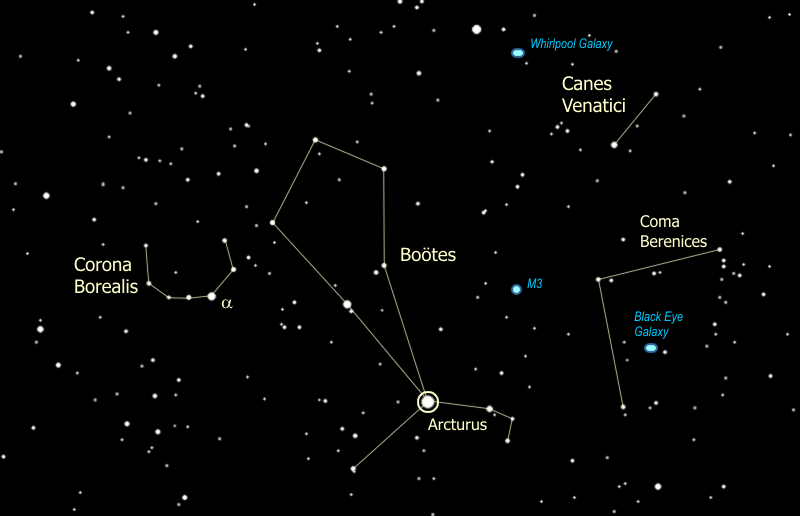
Welcome back to Constellation Friday! Today, in honor of our dear friend and contributor, Tammy Plotner, we examine the Bootes constellation. Enjoy!
In the 2nd century CE, Greek-Egyptian astronomer Claudius Ptolemaeus (aka. Ptolemy) compiled a list of the then-known 48 constellations. Until the development of modern astronomy, his treatise (known as the Almagest) would serve as the authoritative source of astronomy. This list has since come to be expanded to include the 88 constellation that are recognized by the International Astronomical Union (IAU) today.
The constellation Boötes (pronounced Bu-Oh-Tays) is one of these constellations, and was also among those listed in the Almagest. It is frequently called the “Watcher of the Bear”, guarding over the northern constellations of both Ursa Major and Ursa Minor (the Greater and Lesser Bears). It is bordered by Canes Venatici, Coma Berenices, Corona Borealis, Draco, Hercules, Serpens Caput, Virgo and Ursa Major.
According to myth, Boötes is credited for inventing the plough, which prompted the goddess Ceres – a goddess of agriculture, grain crops, fertility and motherly love – to place him in the heavens. There are also versions where Bootes represents a form of Atlas, holding up the weight of the world as it turns on its axis (yet another of Hercules’ labors).
Most commonly, Boötes is taken to represent Arcas, the son of Zeus and Callisto. In this source, Arcas was brought up by Callisto father, the Arcadian king Lycaon. One day, Lycaon decided to test Zeus by serving him his own son for a meal. Zeus saw through Lycaon’s intentions and transformed the king into a wolf, killed his sons, and brought Arcas back to life.
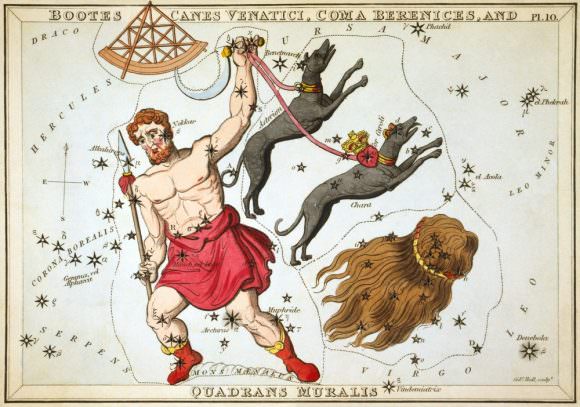
Having heard of her husband’s infidelity, Zeus’ wife Hera transformed Callisto into a bear. For years, she roamed the woods until she met her son, who was now grown up. Arcas didn’t recognize his mother and began to chase her. To avoid a tragic end, Zeus intervened by placing them both in the sky, where Callisto became Ursa Major (aka. The Big Dipper, or “Great Bear”) and Arcas became Boötes.
In another story, Boötes is taken to represent Icarius, a grape grower who was given the secret of wine-making by Dionysus. Icarius used this to create a wonderful wine that he shared with all his neighbors. After overindulging, they woke up the next day with terrible hangovers and believed Icarius had tried to poison them. They killed him in his sleep, and a saddened Dionysus placed his friend among the stars.
Bootes contains the third brightest star in the night sky – Arcturus (aka. alpha Boötis) – whose Greek name “Arktos” also means “bear”, and is associated with all things northern (including the aurora). Arcturus is quite important, being a type K1.5 IIIpe red giant star. The letters “pe” stand for “peculiar emission,” which indicates the spectrum of the star is unusual and full of emission lines. This is not uncommon in red giants, but Arcturus is particularly strong.
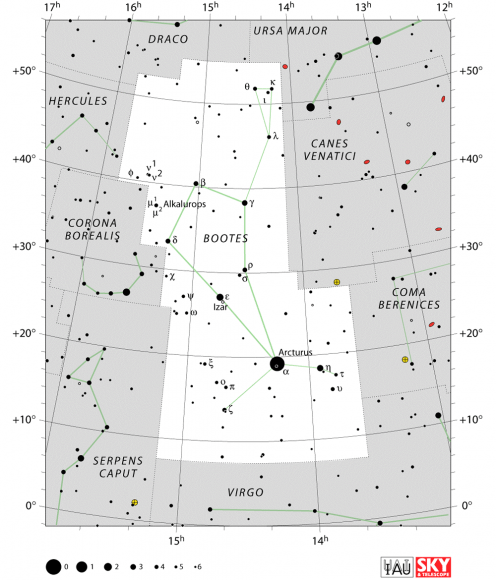
Arcturus is about 110 times more luminous than our nearest star, but the total power output is about 180 times that of the Sun (when infrared radiation is considered). Arcturus is also notable for its high proper motion, larger than any first magnitude star in the stellar neighborhood other than Alpha Centauri. It is now almost at its closest and is moving rapidly (122 km/s) relative to the Solar System.
Arcturus is also thought to be an old disk star, and appears to be moving with a group of 52 others of its type. Its mass is hard to determine exactly, but it may have the same mass as Sol, or perhaps 1.5 times as much. Arcturus may also be older than the Sun, and much like what the Sun will be in its Red Giant Phase.
Arcturus achieved fame when its light was used to open the 1933 Chicago World’s Fair. The star was chosen because it was thought that light from the star had started its journey at about the same time of the previous Chicago World’s Fair (1893). Technically the star is 36.7 light years away, so the light would have started its journey in 1896. Arcturus’ light was still focused onto a cell that powered the switch for the lights that eventually shined so bright that Arcturus was no longer visible.
Arcturus, along with its neighboring stars, also form the curious “Colonial Viper” formation, a triangular asterism invented by dedicated SkyWatcher, Ed Murray. It is so-named because it resembles a Colonial Viper being launched from a tube on the TV series Battlestar Galactica. The “Launch Tube” is formed by the intersection of Arcturus, Alphekka (Alpha Corona Borealis) and Gamma Bootis, while Izar (Epsilon Bootes) is the Viper.

Other notable stars include Nekkar (Beta Boötis), a yellow G-type giant that is 219 light years from Earth. It is a flare star, which is a type of variable star that shows dramatic increases in luminosity for a few minutes. The name Nekkar derives from the Arabic word for “cattle driver”. Then there’s Seginus (Gamma Boötis), a Delta-Scuti type variable star that is approximately 85 light years from Earth. It shows variations in its brightness due to both radial and non-radial pulsations on its surface.
Izar (Epislon Boötis) is a binary star located approximately 300 light years away which consists of a bright orange giant and a smaller and fainter main sequence star. Epsilon Boötis is also sometimes knows as Pulcherrima, which means “the lovieliest” in Latin. The name Izar comes from the Arabic word for “veil.” The star’s other traditional names are Mirak (“the loins” in Arabic) and Mizar.
Muphrid (Eta Boötis) is a spectroscopic binary star that is 37 light years from Earth and close to Arcturus in the sky. The star’s traditional name is Muphrid, derived from the Arabic phrase for “the single one of the lancer.” It belongs to the spectral class G0 IV and has a significant excess of elements heavier than hydrogen.
Boötes is also home to many Deep Sky Objects. This includes the Boötes void (aka. the Great Void, the Supervoid). This sphere-shaped region of the sky is almost 250 million light years in diameter and contains 60 galaxies. The void was originally discovered by Robert P. Kirshner – a Harvard College Professor of Astronomy – in 1981, as part of a survey of galactic redshifts.
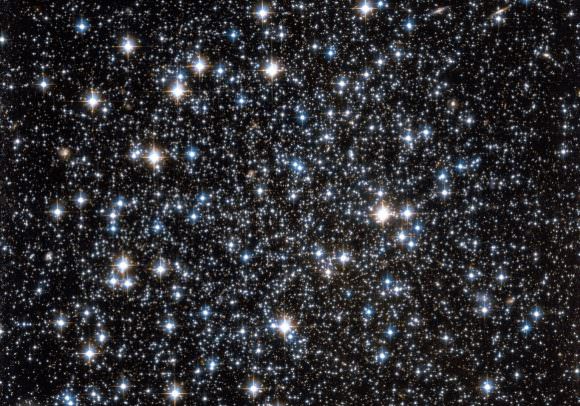
Then there is the Boötes Dwarf Galaxy (Boötes I), a dwarf spheroidal galaxy located approximately 197,000 light years from Earth that measures about 720 light years across. It was only discovered in 2006, owing to the fact that it is one of the faintest galaxies known (with an absolute magnitude of -5.8 and apparent magnitude of 13.1). Boötes I orbits the Milky Way and is believed to be tidally disrupted by its gravity, as evidenced by its shape.
And there’s also NGC 5466, a globular cluster approximately 51,800 light years from Earth and 52,800 light years from the Galactic center. The cluster was first discovered by the German-born British astronomer William Herschel in 1784. It is believed that this cluster is the source of a star stream called the 45 Degree Tidal Stream, which was discovered in 2006.
The earliest recorded mentions of the stars associated with Boötes come from ancient Babylonia, where it was listed as SHU.PA. These stars were apparently depicted as the god Enlil, who was the leader of the Babylonian pantheon and special patron of farmers. It is likely that this is the source of mythological representations of Bootes as “the ploughman” in Greco-Roman astronomy.
The name Boötes was first used by Homer in The Odyssey as a celestial reference point for navigation. The name literally means “ox-driver” or “herdsman”, and the ancient Greeks saw the asterism now called the “Big Dipper” or “Plough” as a cart with oxen. His dogs, Chara and Asterion, were represented by the constellation of Canes Venatici (the Hunting Dogs) who drove the oxen on and kept the wheels of the sky turning.
In traditional Chinese astronomy, many of the stars in Boötes were associated with different Chinese constellations. Arcturus was one of the most prominent, variously designated as the celestial king’s throne (Tian Wang) or the Blue Dragon’s horn (Daijiao). Arcturus was also very important in Chinese celestial mythology because it is the brightest star in the northern sky, and marked the beginning of the lunar calendar.
Flanking Daijiao were the constellations of Yousheti on the right and Zuosheti on the left, which represented the companions that orchestrated the seasons. Dixi, the Emperor’s ceremonial banquet mat, was north of Arcturus. Another northern constellation was Qigong, the Seven Dukes, which was mostly across the Boötes-Hercules border.
The other Chinese constellations made up of the stars of Boötes existed in the modern constellation’s north. These are all representations of weapons – Tianqiang, the spear; Genghe, variously representing a lance or shield; Xuange, the halberd; and Zhaoyao, either the sword or the spear.
Bootes can be found south of Ursa Major, just off the handle of the Big Dipper. Because the Big Dipper is easy for most observers to find, the handle is used to point to other important stars. Bootes’ brightest star, Arcturus, is also part of a mnemonic device used to orient people, which goes: “Arc to Arcturus, speed on to Spica.” This means you follow the curve in the Dipper’s handle away from Ursa Major until you run into Arcturus. The other star – Spica – is part of the neighboring Virgo constellation.
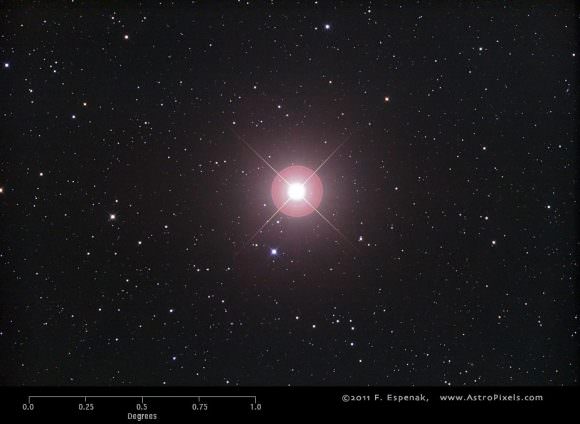
For those using binoculars, check out Tau Bootis, a yellow-white dwarf approximately 51 light-years from Earth. It is a binary star system, with the secondary star being a red dwarf. In 1999, an extrasolar planet was confirmed to be orbiting the primary star by a team of astronomers led by Geoff Marcy and R. Paul Butler. Maybe you’d like to look at long term variable star R Boötis? It ranges from 6.2 to 13.1 every 223.4 days.
For those using telescopes, there are plenty of excellent binary star systems to be seen. Pi Boötis is located approximately 317 light years from our solar system and the primary component, P¹ Boötis, is a blue-white B-type main sequence dwarf with an apparent magnitude of +4.49. It’s companion, P² Boötis, is a white A-type main sequence dwarf with an apparent magnitude of +5.88.
Now try looking at Xi Boötis, a binary star system which lies 21.8 light years away. The primary star, Xi Boötis A, is a BY Draconis variable, yellow G-type main sequence dwarf with an apparent magnitude that varies from +4.52 to +4.67. with a period just over 10 days long. Small velocity changes in the orbit of the companion star, Xi Boötis B – an orange K-type main sequence dwarf – indicate the presence of a small companion with less than nine times the mass of Jupiter.
The AB binary can be resolved even through smaller telescopes. The primary star (A) has been identified as a candidate for possessing a Kuiper-like belt, based on infrared observations. The estimated minimum mass of this dust disk is 2.4 times the mass of the Earth’s Moon.
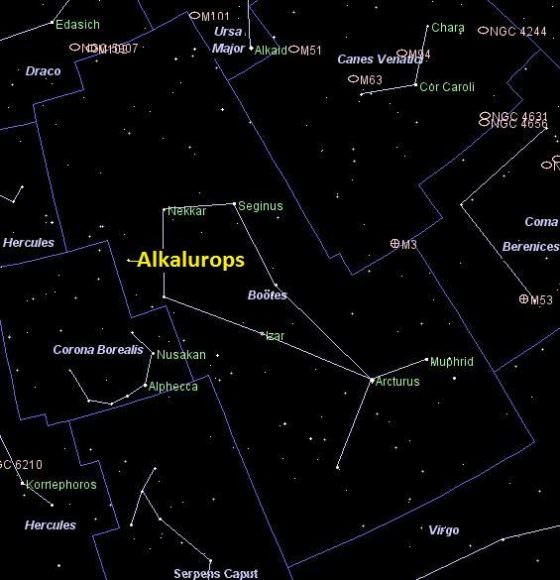
Then there’s the triple system, Mu Boötis. The primary component, Mu¹ Boötis, is a yellow-white F-type sub giant with an apparent magnitude of +4.31. Separated from the primary by 108 arc seconds is the binary star Mu² Boötis, which has a combined spectral type of G1V and a combined brightness of +6.51 magnitudes. The components of Mu² Boötis have apparent magnitudes of +7.2 and +7.8 and are separated by 2.2 arc seconds.
They complete one orbit about their common center of mass every 260 years. How about colorful yellow and blue Kappa Boötis? Kappa2 Boötis is classified as a Delta Scuti type variable star and its brightness varies from magnitude +4.50 to +4.58 with a period of 1.83 hours. The companion star, Kappa¹ Boötis, has magnitude +6.58 and spectral class F1V.
For deep sky observers with large telescopes, try checking out the globular cluster NGC 5466, which is about a fist’s width north of Arcturus. This class XII, 9th magnitude globular was discovered in 1784 by Sir William Herschel and presents an nice challenge for experienced stargazers and amateur astronomers.
Or try compact spiral galaxy NGC 5248. It’s about a fist width south of Arcturus and about a finger width southwest. It’s part of the Virgo cluster of galaxies and could be as far as 50 million light years away. It’s another great grand design spiral which shows spiral galaxy structure when viewed in long exposure photographs. You can mark it on your list as Caldwell 45.

But if you’d just like to have some fun, then why not try picking out the aforementioned “Colonial Viper and Launch Tube” asterism. If you’re a longstanding Battlestar Galactica fan, then you’ll recognize this ultra-cool spaceship as it sits in its triangular shaped launch tube. To find it, just draw a line between Arcturus, Alphekka (Alpha Corona Borealis) and Gamma Bootis which make up the “Launch Tube”, while Izar (Epsilon Bootes) is the Viper.
We have written many interesting articles about the constellation here at Universe Today. Here is What Are The Constellations?, What Is The Zodiac?, and Zodiac Signs And Their Dates.
Be sure to check out The Messier Catalog while you’re at it!
For more information, check out the IAUs list of Constellations, and the Students for the Exploration and Development of Space page on Bootes and Constellation Families.
The Big Dipper is big. Come on, it’s right there in the name. But how big is the Big Dipper if you could see it from all angles?
Ask someone to name a constellation and they’ll usually say the Big Dipper. Anyone living in the Northern hemisphere who can draw a spoon generally can recognize it in the sky.
I am about to shake the foundations of your reality with a level of pedantry that at bare minimum should earn me a solid shaking and possibly even a face punch or two. The Big Dipper is not, and never will be a constellation.
It’s an asterism, a familiar pattern of stars in the sky. There are 88 constellations, and the Big Dipper isn’t one of them. It’s a part of the constellation of Ursa Major. In fact, the handle of your familiar spoon is actually the tail of the great bear.
Now that I’ve lulled you to sleep with some painfully uninteresting specifics, which you can bust out to make yourself unpopular at your AV Club pop and chip parties whenever someone refers to the “Big D” as a constellation. I strongly suggest whatever it is you tell them, you start off with *ACTUALLY….*
And now that you’ve made it this far, I shall reward you with what you’re seeking. Just how big is that Big Dipper? There are a couple of ways to skin this bear’s tail. We can say its size relative to the amount of sky real estate it occupies, or we can do the end to end Kessel run.
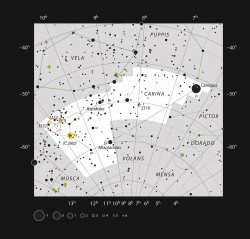
You might be surprised to know how much of the sky it takes up. Astronomers measure the sky in degrees. 360 degrees takes you all the way around the sky, and our Moon measures half a degree across.
Dubhe and Merak are the pointer stars in the Big Dipper. You could put 11 full Moons side to side in the gap between them. And about 40 full Moons from bottom corner of the Dipper to the end of its handle. So, the Big Dipper measures about 20 degrees.
Here are some easy ways to measure sizes. Your pinkie nail, held at arm’s length is half a degree. 3 fingers is 5 degrees, your fist is 10 degrees. Rocking out with devil horns are 15 degrees and hang loose or the inspector gadget phone is 25 degrees.
Trekkers and Trekkies may prefer to use the Vulcan live long and prosper measurement, which is about the same number of degrees you are from getting a romantic companion.
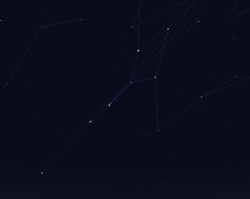
So, stem to stern, how big is our giant celestial ladle? I know you know those things aren’t in anything resembling a straight line. Some of the stars are closer, and some of the stars are further out. If you could make a box that completely surrounded them, how big would it be?
The closest star in the asterism is Megrez at 58 light years. and the most distant is Dubhe at 124 light-years. And yet, they all look roughly the same brightness. This means that Dubhe is a much brighter star than Megrez, and it’s just further away. Because these stars are moving in the sky what we see as a Big Dipper today didn’t always look this way. 150,000 years ago, the Big Dipper looked like this (above).
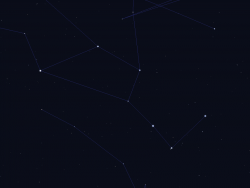
And in 150,000 years from now it’ll look like this (left). Less dipper, more plow-like. Or maybe a shoe form? Shoes are kind of like ladles, right? Super gross, terribly unhygenic ladles.
Our brains keep from exploding by being pattern making machines. We see collections of stars in the sky and turn them into shapes. But it’s all just a matter of perspective. You’ve got to be right here and now to see the sky we do. Unless you’re looking for a giant “W” in which case you’ll always find one of those. It may not be the constellation Cassiopeia, but it’ll still be a pattern in the stars.
What’s your favorite asterism? Tell us in the comments below.
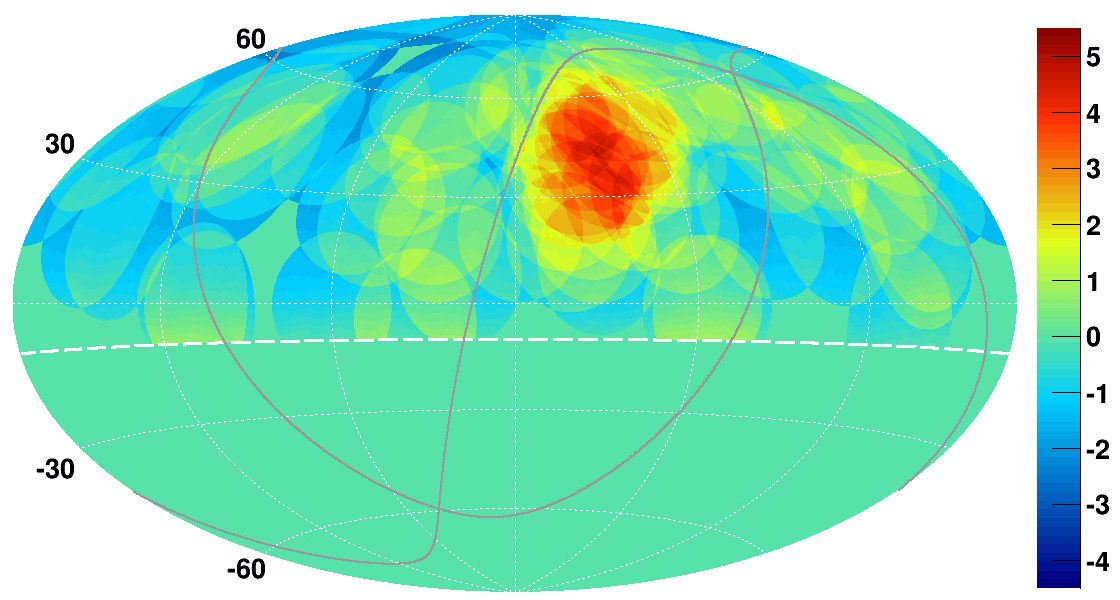
Behind the Big Dipper is something pumping out a lot of extremely high-energy cosmic rays, a new study says. And as astronomers try to learn more about the nature of these emanations — maybe black holes, maybe supernovas — newer work hints that it could be related to how the universe is structured.
It appears that the particles come from spots in the cosmos where matter is densely packed, such as in “superclusters” of galaxies, the researchers stated, adding this is promising progress for tracking down the source of the cosmic rays.
“This puts us closer to finding out the sources – but no cigar yet,” stated University of Utah physicist Gordon Thomson, co-principal investigator for the Telescope Array that performed the observations. “All we see is a blob in the sky, and inside this blob there is all sorts of stuff – various types of objects – that could be the source,” he added. “Now we know where to look.”
The study examined the highest-energy cosmic rays that are about 57 billion billion electron volts (5.7 times 10 to the 19th power), picking that type because it is the least affected by magnetic field lines in space. As cosmic rays interact with the magnetic field lines, it changes their direction and thus makes it harder for researchers to figure out where they came from.

Scientists used a set of 500 detectors called the Telescope Array, which is densely packed in a 3/4 mile (1.2 kilometer) square grid in the desert area of Millard County, Utah. The array recorded 72 cosmic rays between May 11, 2008 and May 4, 2013, with 19 of those coming from the “hotspot” — a circle 40 degrees in diameter taking up 6% of the sky. (Researchers are hoping for funding for an expansion to probe this area in more detail.)
It’s possible the hotspot could be a fluke, but not very possible, the researchers added: there’s a 1.4 in 10,000 chance. And they’re keeping themselves open to many types of sources: “Besides active galactic nuclei and gamma ray emitters, possible sources include noisy radio galaxies, shock waves from colliding galaxies and even some exotic hypothetical sources such as the decay of so-called ‘cosmic strings’ or of massive particles left over from the big bang that formed the universe 13.8 billion years ago,” the researchers stated.
Cosmic rays were first discovered in 1912 and are believed to be hydrogen nuclei or the centers of nuclei from heavier elements like iron or oxygen. The highest-energy ones in the study may come from protons alone, but that’s not clear yet.
The paper is available in preprint version on Arxiv, and has been accepted for publication in Astrophysical Journal Letters.
Source: University of Utah
They’re out there; tiny, extremely faint and incredibly ancient dwarf galaxies with so few stars that scientists call them ‘ghost galaxies.’ NASA’s Hubble Space Telescope captured images of three of these small-fry galaxies in hopes of unraveling a mystery 13 billion years in the making.
Astronomers believe these tiny, ghost-like galaxies spotted alongside the Milky Way Galaxy are among the oldest, tiniest and most pristine galaxies in the Universe. Hubble views reveal that their stars share the same birth date. The galaxies all started forming stars more than 13 billions years ago but then abruptly stopped within just one billion years after the Universe was born.
“These galaxies are all ancient and they’re all the same age, so you know something came down like a guillotine and turned off the star formation at the same time in these galaxies,” said Tom Brown of the Space Telescope Science Institute in Baltimore, Md., the study’s leader. “The most likely explanation is reionization.”
Reionization of the Universe began in the first billion years after the Big Bang. During this time, radiation from the first stars knocked electrons off hydrogen atoms, ionizing the hydrogen gas. This process also allowed hydrogen gas to become transparent to ultraviolet light. This same process may also have squashed star-making in dwarf galaxies, such as those in Brown’s study. These galaxies are tiny cousins to star-making dwarf galaxies near the Milky Way. And because of their small size, just 2,000 light-years across, they were not massive enough to shield themselves from the harsh ultraviolet light of the early Universe which stripped away their meager supply of hydrogen gas, leaving them unable to make new stars.
Astronomers proposed many reasons for the lack of stars in these galaxies in addition to the reioniation theory. Some scientists believed internal events such as supernovae blasted away the gas needed to create new stars. Others suggested that the galaxies simply used up their supply of hydrogen gas needed to make stars.
Brown measured the stars’ ages by looking at their brightness and colors. The stellar populations in these fossil galaxies range from a few hundred to a few thousand stars; some sun-like, some red dwarfs and some red stars larger than our Sun. When evidence showed that the stars were indeed ancient, Brown enlisted the help of Hubble’s Advanced Camera for Surveys to burrow deep within six galaxies to determine when they were born. So far, the team has finished analyzing data for three; Hercules, Leo IV and Ursa Major. The galaxies lie between 330,000 light-years to 490,000 light-years. For comparison, Brown compared the galaxies’ stars with those found in M92, a 13 billion-year-old globular cluster located about 26,000 light-years from Earth. He found they are of similar age.
“These are the fossils of the earliest galaxies in the universe,” Brown said. “They haven’t changed in billions of years. These galaxies are unlike most nearby galaxies, which have long star-formation histories.”
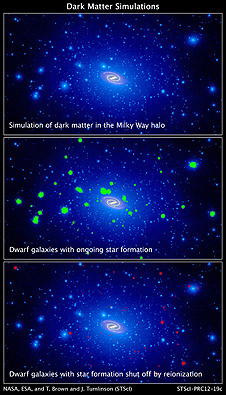 Brown’s discovery could help explain the so-called “missing satellite problem.” Astronomers have observed only a few dozen dwarf galaxies around the Milky Way while computer simulations predict thousands should exist. But perhaps they do exist. The Sloan survey found more than a dozen tiny, star-starved galaxies in the Milky Way’s neighborhood while scanning just a portion of the sky. Astronomers think that dozens more ultra-faint galaxies may lurk undetected with the possibility of thousands of even smaller dwarfs containing virtually no stars.
Brown’s discovery could help explain the so-called “missing satellite problem.” Astronomers have observed only a few dozen dwarf galaxies around the Milky Way while computer simulations predict thousands should exist. But perhaps they do exist. The Sloan survey found more than a dozen tiny, star-starved galaxies in the Milky Way’s neighborhood while scanning just a portion of the sky. Astronomers think that dozens more ultra-faint galaxies may lurk undetected with the possibility of thousands of even smaller dwarfs containing virtually no stars.
The tiny galaxies may be star-deprived but they still have an abundance of dark matter, the framework upon which galaxies are built. Normal dwarf galaxies near the Milky Way Galaxy contain ten times more dark matter than ordinary visible matter. Brown explains that these tiny galaxies are now islands of mostly dark matter, unseen for billions of years until astronomers began finding them in the Sloan Survey.
Brown’s results appear in the July 1 issue of the Astrophysical Journal Letters.
Image caption 1: These Hubble images show the dim, star-starved dwarf galaxy Leo IV. The image at left shows part of the galaxy, outlined by the white rectangular box. The box measures 83 light-years wide by 163 light-years long. The few stars in Leo IV are lost amid neighboring stars and distant galaxies. A close-up view of the background galaxies within the box is shown in the middle image. The image at right shows only the stars in Leo IV. The galaxy, which contains several thousand stars, is composed of sun-like stars, fainter, red dwarf stars, and some red giant stars brighter than the sun. Credit: NASA, ESA, and T. Brown (STScI)
Image caption 2: These computer simulations show a swarm of dark matter clumps around our Milky Way galaxy. Some of the dark-matter concentrations are massive enough to spark star formation. Thousands of clumps of dark matter coexist with our Milky Way galaxy, shown in the center of the top panel. The green blobs in the middle panel are those dark-matter chunks massive enough to obtain gas from the intergalactic medium and trigger ongoing star formation, eventually creating dwarf galaxies. In the bottom panel, the red blobs are ultra-faint dwarf galaxies that stopped forming stars long ago. Credit: NASA, ESA, and T. Brown and J. Tumlinson (STScI)

We wanted to spend a few shows talking about some of the most recognizable constellations in the night sky. We’ve chatted about Orion the Hunter, but now we’re going to talk about the Big Dipper, also known as Ursa Major, or the Great Bear – apologies to our southern hemisphere listeners.
Click here to download the episode.
Or subscribe to: astronomycast.com/podcast.xml with your podcatching software.